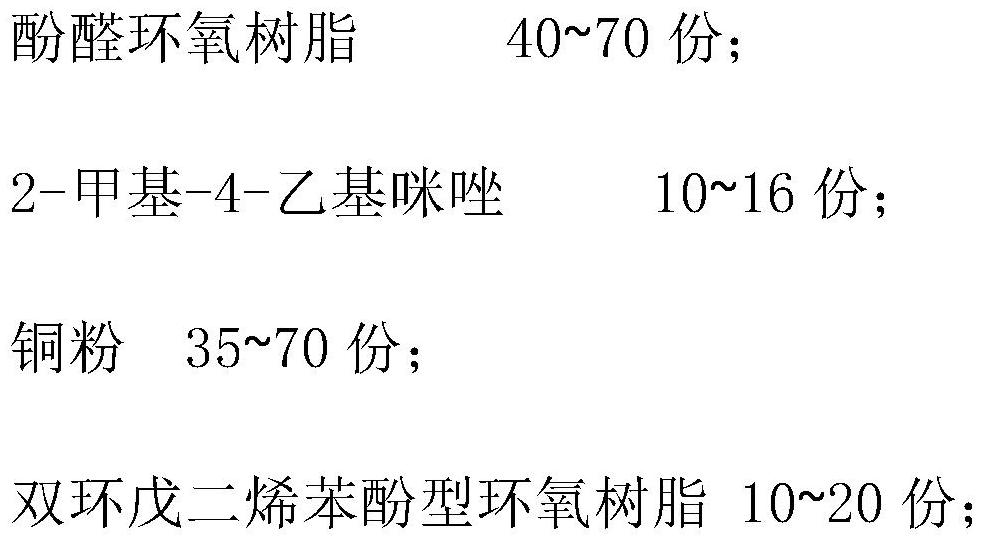A kind of temperature-resistant conductive adhesive and its preparation method and application
A conductive adhesive and adhesive technology, applied in conductive adhesives, adhesives, novolak epoxy resin adhesives, etc., can solve problems such as the decrease in the strength of the bonding layer, reduce deformation differences, reduce production costs, The effect of reducing the probability of adhesive failure
- Summary
- Abstract
- Description
- Claims
- Application Information
AI Technical Summary
Problems solved by technology
Method used
Image
Examples
Embodiment 1
[0024] The raw materials of a temperature-resistant conductive adhesive are: 40g of phenolic epoxy resin, 20g of dicyclopentadiene phenolic epoxy resin, 16g of 2-methyl-4-ethylimidazole, 55g of 200-mesh copper powder, 30 Purpose copper powder 7g.
[0025] Firstly, novolac epoxy resin and dicyclopentadiene phenolic epoxy resin are melt blended, stirred until uniform and ready for use; before using as an adhesive, mix the aforementioned mixed resin with 2-methyl-4-ethylimidazole and copper Powder mix well.
Embodiment 2
[0027] A temperature-resistant conductive adhesive consists of raw materials: 70g of novolac epoxy resin, 13g of dicyclopentadiene phenolic epoxy resin, 10g of 2-methyl-4-ethylimidazole, 35g of 150 mesh copper powder, 35g Purpose copper powder 6g.
[0028] Firstly, novolac epoxy resin and dicyclopentadiene phenolic epoxy resin are melt blended, stirred until uniform and ready for use; before using as an adhesive, mix the aforementioned mixed resin with 2-methyl-4-ethylimidazole and copper Powder mix well.
Embodiment 3
[0030] The raw materials of a temperature-resistant conductive adhesive are: 50g of phenolic epoxy resin, 10g of dicyclopentadiene phenolic epoxy resin, 14g of 2-methyl-4-ethylimidazole, 60g of 100-mesh copper powder, 40 Purpose copper powder 8g.
[0031] Firstly, novolac epoxy resin and dicyclopentadiene phenolic epoxy resin are melt blended, stirred until uniform and ready for use; before using as an adhesive, mix the aforementioned mixed resin with 2-methyl-4-ethylimidazole and copper Powder mix well.
PUM
| Property | Measurement | Unit |
|---|---|---|
| length | aaaaa | aaaaa |
Abstract
Description
Claims
Application Information
 Login to View More
Login to View More - R&D
- Intellectual Property
- Life Sciences
- Materials
- Tech Scout
- Unparalleled Data Quality
- Higher Quality Content
- 60% Fewer Hallucinations
Browse by: Latest US Patents, China's latest patents, Technical Efficacy Thesaurus, Application Domain, Technology Topic, Popular Technical Reports.
© 2025 PatSnap. All rights reserved.Legal|Privacy policy|Modern Slavery Act Transparency Statement|Sitemap|About US| Contact US: help@patsnap.com


